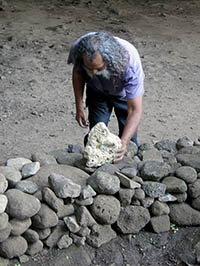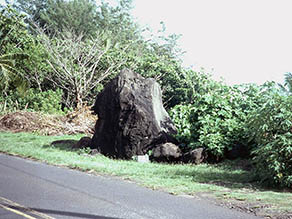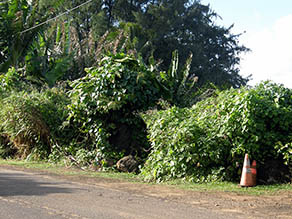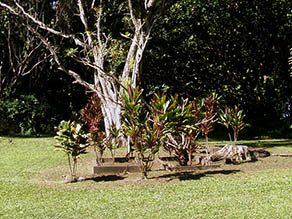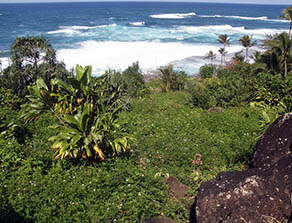 |
 |
 |
 |
||||||
|
|
|
|
|
|
|
|
|
|
 |
|
 |
|||||||||||
 |

|
 |
|
 |
Hā‘ena is rich in sites of sacred and legendary importance. In modern, planning parlance, these are often referred to as “cultural resources.” But for Hawaiians they retain a powerful significance that makes their use as “resources”—especially for tourism—problematic. 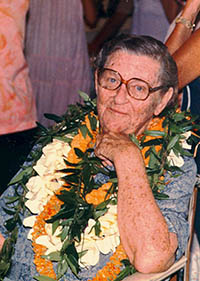
“Juliet Wichman, who is the one who traded land and saved the valley of Limahuli, laid down on the highway in front of county trucks who were coming to take rocks from Kē‘ē and use them to build things in Hanalei or wherever,” Makaala recounts. “In those days, that’s what you did. This would have been the late fifties, early sixties. "And in those days they were county rocks and county trucks, and they just did. And she understood the value of those things in that place. What they were doing was destroying Lōhi‘au’s house site and the heiau and a few other things. They had no concept that that’s what they were doing, but she knew it. She was quite something. She just knew that what was right was right and she was a Rice, so she was definitely of the place. I have Rice roots as well. “And she said what she said, and did what she did, and because she laid down in front of the truck, of course the men had no idea what to do next, and they left. And that I think was one of the beginnings of the returning of that place. I was told that story as a young person, and I use that story to empower me to stand up for what I think is right. Again, I’m not from this place and so in our tradition, that’s not normally done. That’s not okay. It’s easier for a woman than it is for a man, no doubt. It’s certainly easier now for me because my husband is from here, but I would have done it anyway. The history of Hā‘ena and pushy women is long and strong.” “Well, I’ve been bringing up these issues with Presley,” Kelii says, “on taking care of our place from the County Park—from the dry cave, Maniniholo—from there all the way down, we go take care. Because, oh man, in the old days you could see every wall so clearly—clean, spick and span. “When the County used to man the road,” Nalani interjects, “the roadways used to be scenic.” “No water would run on the road, the drains would be all working, I mean clean,” Kelii continues. “Always had a view. No poison used, all hand work, sickle—all hand work. But we got a lot to do right now—the Hui—so our priority now is to get us situated in our new place we are building at the lo‘i. And after we get all that done, then we can go out and go meet with the County, because we brought it to the mayor’s attention that we wanted to take care of the road sites, and that’s when we cleared all that. Parts of the road is state. Where Maniniholo comes to Hale Pōhaku, all where the kamani stay, that’s County.” Pōhaku loa—one of the roadside sites—has become completely overgrown in the last fifteen years. “I think there were times when there is an effort to clean it up,” Kawika says, “but then the surfers would come and just sit on top of it and watch the waves. To put your butt on something, that is really disrespectful. So then there is a response like, “Okay, well maybe you should just let the thing be covered by the brush and so that way at least the brush will protect it from being disrespected.”
|
 |
||
 |
Pōhaku-loa, 2000.
|
Pōhaku-loa, 2017. |
 |
 |
“Yeah, they climb on top of them,” Lahela says about the sacred sites in general. “It’s pretty sad, but sometime they’re not thinking people. When Moku did the walls at the cave, one of the boys had called him saying, ‘Uncle, the wall, they knocked the wall down,’ so he must have fixed them up last weekend.” Carlos points out the old cemetary in the lo‘i area: “There are no head stones. There’s stones on the ground but there are no formal head stones. But it’s a marked and recognized cemetery. That one is a recognized because it happened in what they call ‘historical times,’ Christian times, post-Christian times, post-missionary times. And the families—these families that are affiliated with the Hui—have ancestors there, that they know. And so one of the things about the park is that the descendants of the people that have the traditional and customary rights to go and take care of the graves. So that’s another way, after doing some research, we found that the families could come down and continue to take care of those graves.”
“As far as the hula heiau,” Nalani says, “part of it is state, part of it is county. Folks from the community , hula hālaus come and take care of it. “We had the place really manicured, man,” Kelii adds, “but took our focus away from that place—and in all other places that we have—when our fishing rules had to through legislature. I tell you, meetings, and meetings, and hearings just took all our time. A whole year. Every week we’re flying we go meet with these guys. Meet with this legislature, meet with the representatives, do this, do that. But you know what? We were not going to give up. We made it that was our part. We going to do ‘em, we going to take care of our place. We going to be the first to do this for all the other communities to follow behind us.” “The place was very neglected when I finally got to go there,” Uncle Nathan recalls. “So I decided to become a part of a non-profit organization that was run here by kumu hula Roselle Bailey, who lived of the west side of O‘ahu. She’s actually from Maui, I believe her family comes from, but she was teaching here on Kaua‘i. Very traditional in her ways. I became a part of her non-profit and became an officer. “One of the kuleana of her non-profit was to go and mālama the place. So we would go and take our sickle and whatever and go cut, and we did that for quite a while. She called kumu hula from all over to come on a specific date we were going to have ceremonies, and everybody come do how you were taught to. She invited OHA, Alu Like, Hawaiian organizations besides hālau to bring their ho‘okupu. It was wonderful to be part of that. It went on for several years, and eventually it kind of faded out. She felt there was not enough support from the community at large.”
|
 |
||
 |
While the sites of Haena are preserved, so too are the values, replanted and modified for tomorrow's generation.
|
 |
||
 |
|
 |
||

|
|
||||
| Copyright 2018 Pacific Worlds & Associates • Usage Policy • Webmaster |
||||
